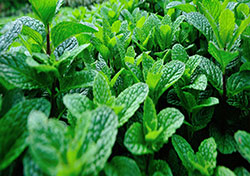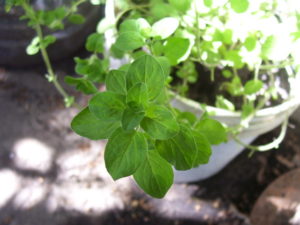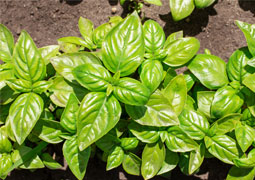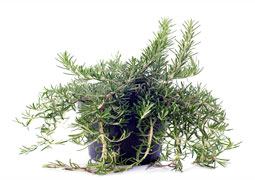Rosemary is a good source of many types of vitamins and essential nutrients that suffice the nourishing requirements of a human being. Additionally, rosemary is found to be beneficial to the extent of providing cure for many serious illnesses such as Alzheimer’s, cancer, asthma, cancer, etc.
Interestingly, due to its fresh and woody fragrance, many manufacturers have been using rosemary as a body perfume, through its natural oil.
In the culinary world, rosemary is often used as an added spice in all types of meat, especially when roasted, and is commonly combined with some lemon and thyme.
These are just some of the things that you can do with either fresh or preserved rosemary. Imagine what more other dishes you can experiment with and what other products to create if you grow and harvest your own rosemary plant.
Read through this entire article and discover how you can harvest rosemary while keeping the entire plant thriving.
Growing Conditions
If you are situated in the warmer region of the earth and would like to have a fairly bushy garden that needs no high maintenance, rosemary can be one of your best options to grow. This herb thrives well in warm places, plus its thick and vigorous growth can help add a strong touch if you’re planning on putting up a rock garden in your front yard.
While rosemary is considerably a low maintenance plant, there are still some growing requirements that you need to take into account if you want to properly grow rosemary on your own.
- Weather Conditions
Rosemary adapts well to high temperature and humidity. It can tolerate as low as 30 degrees F but any more degrees lower than that and you will have to bring your rosemary indoors or it will suffer from damages. This is also the very reason why rosemary is more preferred to be grown in containers instead directly on the ground.
- Sun Exposure
Full sun is always the best for your rosemary. As much as possible, it needs at least 6 hours of sunlight everyday, whether you are growing it outdoors or indoors. If you are doing the latter, make sure that the sun exposure requirements are still met by going to the extent of using artificial light. It will also help if you will place your rosemary by the window where natural light can pass through.
- Soil Requirements
Rosemary thrives in a loamy, well-drained soil with a pH between six and seven. It can also tolerate poor soil, but you could still use a bit of fertilizer to aid its vigorous growth.
- Watering
It being fairly drought-tolerant, watering rosemary is not totally necessary to be done more frequently. Only water your herb when the soil has completely dried out, but be careful not to overwater it; you just need to moisten the soil. Rosemary is originally grown in the rocky hillsides of the Mediterranean, thus it does not grow well when its roots are way too soaked with water.
- Spacing
Surprisingly, rosemary can grow into a massive, thick plant especially in warmer areas that is why it is recommended to allot about 3 feet of space between each rosemary plant to allow it to grow without risking overlapping with each other.
Pro tip: this spacing will be easily maintained if you plant your rosemary in a container so you can quickly transfer it from one place to another especially before the first frost comes.
- Companion Planting
Rosemary and broccoli are mutually beneficial with each other so you might want to plant them alongside each other. Rosemary is also proven to be a good companion plant of beans, cabbages, carrots, and hot peppers as rosemary helps repel pests and encourage other plants to flourish.
Harvest Period
If you want to make the most out of your rosemary plant, you might want to make your first harvest during the spring and summer when the temperature is high and the rosemary is at its most active state.
During this season, rosemary grows faster than usual so the sprigs that you harvest will immediately grow back. You can harvest daily or weekly, as needed. Harvesting rosemary regularly will encourage it to grow more and produce fresher leaves.
You will also know that your rosemary is ready for harvest when you measure some of its branches and they are already 8 inches high. Branches shorter than 8 inches should be left behind to give them more time to mature.
Process Of Harvesting Rosemary
Rosemary can tolerate both single and heavy harvesting for as long as you are doing it the proper way.
- Harvest rosemary when it is most active, particularly during spring and summer and pick only those branches that are 8 inches tall or longer.
- Using garden shears, cut the tender, top portion of the rosemary. Avoid cutting the hard and woody stems which are found at the base of the plant.
- To make sure that you don’t kill the plant while making your harvest, l
- Leave at least ¾ of the plant for it to continue to grow. For instance, if a branch is already 8 inches long, just snip off 2 inches of it and leave 6 inches intact.
- If you are not harvesting in large amounts, you might want to prioritize harvesting the longer and overgrown branches first.
- Since rosemary is known for its rapid and vigorous growth, you can also take this opportunity to trim your rosemary and keep its shape compact and orderly.
Storing And Using
During the hot season, your garden is probably overflowing with new and fresh rosemary so harvesting everyday won’t definitely be a problem. However, when the winter comes how are you supposed to fill your kitchen and spice up your favorite dishes with rosemary’s tea-like and peppery aroma? The answer? Know how to store and preserve them in various ways possible.
A. Store the rosemary in the refrigerator
- Wash your rosemary and then dry it completely, otherwise it will get slimy once stored in the refrigerator.
- Wrap the rosemary in a damp paper towel to keep it from drying out in the fridge.
- Place the rosemary inside a ziplock bag or an airtight container.
- Put it inside the crisper compartment. Storing it in the refrigerator will maintain the herb’s freshness up to 2 weeks.
B. Freeze the rosemary
- Lay the rosemary sprigs flat on a baking sheet. Be careful not to overcrowd it and leave about an inch of space between each other, or else they will stick to each other once frozen.
- Put the rosemary in the freezer for a few hours. Check every hour to see if the sprigs are frozen enough. This means that they don’t droop or bend easy when you pick them up straight.
- Once frozen, put the rosemary inside a ziplock bag. Press all the air out before tightly closing the container bag to maximize the space in the freezer.
- Put the rosemary back into the freezer. Doing this method will more likely preserve the freshness of the rosemary for several months to a year.
C. Hang dry the rosemary
- Remove a few leaves, about 1 to 2 inches, from the bottom part of the rosemary stem.
- Gather all the sprigs and tie altogether the bottom part from where you removed the leaves.
- Hang the rosemary in a dark, clean space, typically a basement or any room where sunlight can hardly pass through. Avoid also from hanging it in places near smoke, dust, or steam.
- Check the rosemary every once in a while to see if it has perfectly dried. If you run your fingers through the dried rosemary and it falls easy like flakes, then it is good to go. However, if it immediately becomes powdery, it is a clear indicator that the rosemary is overdried and may not be as flavorful.
- Crumble the dried rosemary and place them inside a container. Make sure that the lid is tightly closed for it to last longer.
D. Bake the rosemary in the oven
- After rinsing rosemary with cold water, lay it flat on a clean sheet.
- Let it air dry for about 10 minutes before actually putting it in the oven. Baking a damp rosemary will take the process a lot longer.
- Lay the air dried rosemary on a baking sheet, leaving an even space between each sprig.
- Set your oven to the lowest temperature and slow bake to avoid your rosemary from being burned.
- Preferably, bake the rosemary for 30 minutes. After the first 15 minutes, open the door of the oven for a minute to let the moisture out.
- After 30 minutes, check if the leaves flake apart when crumbled. If not, bake it for another 10 to 15 minutes.
- When done, let it rest. Put the cool, dried rosemary in an airtight container.





